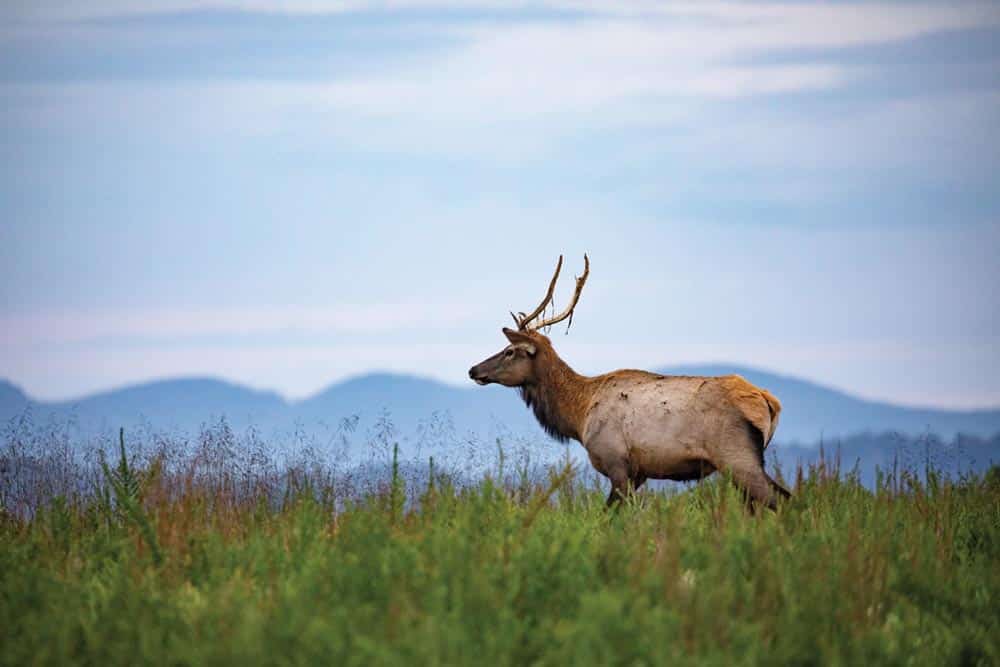It isn’t necessary to travel out west to hear the beautifully haunting sound of an elk bugle echo through the mountains. Elk restoration efforts are taking place in certain parts of Appalachia, where abandoned mine lands are being turned back into a natural habitat for these native animals.
Between 2012 and 2014, the Virginia Department of Wildlife Resources (DWR) reintroduced 75 elk from the Kentucky Department of Fish & Wildlife Resources’ (KDFWR) population in Buchanan County, Va. This area of southwest Virginia has undergone significant mountaintop removal coal mining that resulted in the decimation of mountains, trees, and vegetation. But as devastating as these mining methods have been to the region’s landscapes, they’ve created a ratio between open land and wooded areas that is ideal for sustaining an elk population.

“Elk are herbivores, so their diet primarily relies on grasses and forbs they find in open fields like these while using the forested areas to stay cool in the heat,” said Jackie Rosenberger, elk project leader for Virginia DWR.
“The nice thing is that by reclaiming these mine lands, we’re not only benefiting elk, we’re also benefiting a suite of other species. We’re basically bringing back these early successional plant communities that are great for other game species such as deer, bear, and turkey, but it’s also great for nongame species as well. We have tons of pollinators and grassland bird species that you just wouldn’t see in a mostly forested landscape here in Buchanan County.”
Similarly, Kentucky’s elk restoration project utilizes abandoned mine lands to support their now booming population. What started with 1,500 elk released into eastern Kentucky in the early 2000s has grown to nearly 16,000 elk living on the land, giving the Virginia project hope and guidance for developing their plans and building partnerships.
“This [elk] is a native species and a very large animal, but yet we’re still finding that even with all the development in the world, we still have a place for these animals and we greatly value them,” said Seth Thompson, district wildlife biologist for DWR. “We’re talking about a pretty diverse group of stakeholders and people that are interested in this particular species. It’s not just hunters, but folks that just enjoy photography or just enjoy the outdoors and being in the mountains in a beautiful place like this. Elk are bringing a lot of people together from all walks of life.”
Since the release in 2014, the Virginia population has grown to over 250 elk, with the majority of the herds staying within five to 10 kilometers of the original restoration site, which includes abandoned mines and private lands. Continuous efforts are required to create an ideal habitat for Virginia’s elk herds, including improving soil quality, removing invasive plant species, and planting seed mixes that provide quality forage and cover for elk.

“We’re really interested in figuring out how we can utilize these lands to create benefits not just for nature, but for people as well,” said Brad Kreps, Clinch Valley program director at the Nature Conservancy, which is working with DWR on the elk restoration project. “For elk restoration, we are looking at former mine lands and thinking about their potential to support elk and bringing elk back to Virginia, as well as supporting the growth of ecotourism and wildlife tourism in the cornfield counties as supportive as communities and economic diversification.”
Before Europeans settled in the region, elk were found all throughout eastern North America, including Virginia. Unfortunately, by the late 1800s, unsustainable hunting and change in land use resulted in the extinction of the eastern elk.

“We are not introducing an animal. This is a native animal that was on our landscape just 200 years ago,” Rosenberger said. “It’s such a great experience for people just to be able to view wildlife and experience and appreciate nature by seeing such a large, charismatic animal being restored to our landscapes.”

According to organizers, the continued efforts to bring back the elk population in Virginia not only benefit the local economy and environment but also inspire future restoration projects. Visitation to see the elk has exceeded expectations with people taking tours year-round and participating in events like the Southern Gap Elk Fest.

As the project continues to grow, more antlers will slowly emerge from behind misty hillsides in the mountains of Virginia. “Just knowing that elk are here is special,” Thompson said. “It’s something that just makes these mountains feel more wild.”
Cover photo: Elk are thriving in Southwest Virginia since being reintroduced a decade ago. Photo by Shannon McGowan








